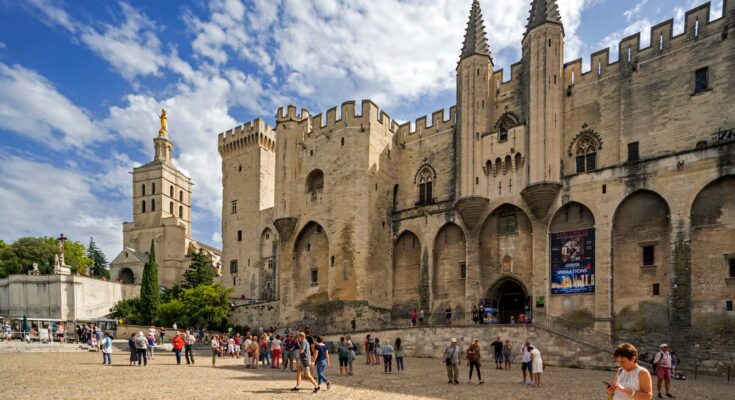Double celebration in Avignon, jewel of French Provence: 30 years since its proclamation as a UNESCO world heritage site and 25 years since its reign as European cultural capital. They celebrate it with the program Avignon, land of culture 2025. Located on the banks of the Rhone, surrounded by walls, it is known as the city of the popes, as seven popes resided there between 1309 and 1377. The so-called “Western Schism” (1378-1417) followed, with up to three popes or antipopes excommunicating each other.
They left in the city a splendid Gothic palace and cardinal palaces, as well as churches and many artistic treasures. Everything is at your fingertips: today you get on the AVE in Madrid, Zaragoza or Barcelona and without leaving your seat you land in Avignon. There awaits the legacy of history, but also many new features of a city that breathes and moves in a big way.
Avignon is pure theatre
Facing the Place de l’Horloge or Town Hall square, the Casa Jean Vilar opened its doors last July. It was he who created the Theater Festival in 1947 which made the city famous. A cultural event that has grown over the years, as evidenced by this splendid installation, now permanent. Every summer up to 1,500 performances are organized per day, yes, you read that right, thanks to the official stages, but also to the so-called éphémères theaters (ephemeral theatres): every corner of the city can host one or more shows, from morning to evening, by professional groups or amateurs from all over the world. The official numbers: 176 stages, 1,742 shows and 27,700 performances.
More news and secrets
Last June a new museum opened its doors: the Musée Des Bains Pommer, the public baths active from 1890 to 1972. Carefully preserved and restored, they are a sort of album or intimate diary of a progressive city. Another unusual statement: the Monte de Piedad, the oldest in France (1610), installed in the building called Condition des Soies, that is, the place where the silk brought from the East rested and acclimatised. The history and objects of Monte de Piedad paint a domestic picture of local society. The Municipal Archive is also located there.
A couple of streets away is Les Halles or central market, transformed into a place to meet and relax, as every day more and more food stalls are transformed into snack bars or restaurants, as happens in other big cities. The façade of Les Halles is a vertical garden designed by the pioneer Patrick Blanc (the same author of the walls of the CaixaForum in Madrid or the Branly Museum in Paris). Two other unusual places: the Mediathèque Ceccano, a library housed in the only cardinal’s palace which has preserved its coffered ceilings and walls covered in frescoes (now faded, due to the plaster that covered them), and, just across the street, the Anglodon Museum, the private collection of a Parisian stylist which brings together works by Van Gogh, Picasso, Modigliani, Cézanne…
The obligatory path
Or whatever the French call it the unstoppablethe essential. First of all, obviously, the Palace of the Popes. A Gothic mass built in less than twenty years starting from 1335. Today it is a sort of joyful labyrinth, after the interventions of time. But you can get a glimpse of its glory days thanks to Histopad tablets and QR codes covering current nudity. Him holy of holies of the palace are the papal apartments, covered with frescoes by Matteo Giovanetti.
On one side of the palace, in the same square, is the Petit Palais Louvre, a former cardinal’s palace transformed into a museum, with a surprising collection (Louvre depot) of Italian primitives and the so-called “Avignon school”, with paintings from the 14th to the 16th century. Another unmissable museum is the Calvet, in an 18th century palace, with paintings and sculptures from the 15th to the 20th century. It must be said that all public museums in Avignon are free. Like the minibuses (for four or five people) which have a fixed route through the historic centre, you just need to make a hand gesture to get on and off at any point along the route.
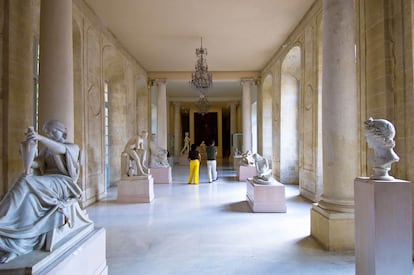
A famous bridge and an unknown island
The St Bénézet bridge is famous throughout the world thanks to the song Sur le pont / d’Avignon/ up and dancing, up and dancing… which is not missing in any French method. Although the music is older, it was the 19th century composer Adolphe Adam who popularized it by introducing it into one of his operettas. There were several bridges at that point, washed away by floods or wars; The current one, with only four arches that cut across the middle of the river, isn’t that it was destroyed, it’s that it was never finished. To access the bridge you have to pay the “derecho de pontazgo”, that is, go through the ticket office (you can buy the ticket online).
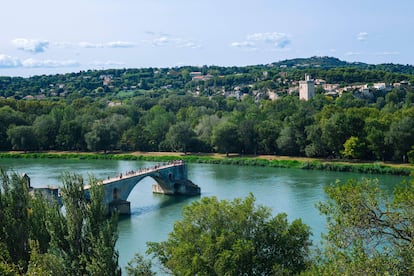
In front of the bridge and the wall that divides the Rhone, the island of Barthelasse extends, up to twenty kilometers long. It’s like the lungs of the city, a sort of wild park suitable only for bikes, hikers and bird watchers – although a few neighbors live there too and there are a couple of restaurants with a view. To reach the island you can take a small ferry or shuttlewhich is free.
Go to Escape to Villeneuve-les-Avignon
On the other side of the Rhone, opposite the city of the Popes, lies the city-district of Villeneuve-les-Avignon. It was the territory of the king, not of the popes, although some cardinals built their palaces there. King Philip the Fair, to put things right, had the tower that bears his name built at the end of the macro bridge that once existed, with up to 22 arches. And on the hill overlooking this shore he built the imposing Fort of San Andrés. You can visit the walled ring of the castle. Inside, the Abbey of Sant’Andrea preserves some buildings and ruins. But above all, its Italian gardens and belvederes with splendid views of Avignon and its countryside stand out.
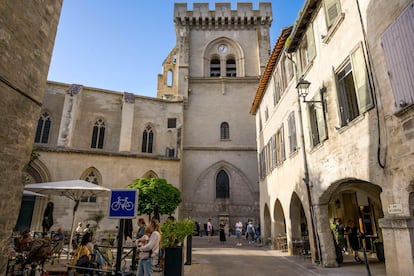
The most surprising thing, however, about Villeneuve is its Charterhouse. An immense enclosure, very well restored and conditioned, where you can visit the cloisters, the cells of the friars and lay people, the chapel with frescoes by Matteo Giovanetti, the laundry, the prison, etc. Searching its recesses can occupy the morning or the afternoon. There is a restaurant, in one of the cloisters, for refreshments.
The Petrarca fountain
The Sorgue river, a tributary of the Rhone, moved the water wheels of the artisan workshops of Avignon, as can still be seen in Rue des Teinturiers. Upstream, the Sorgue also moved the wheels of tanners, weavers, dyers, etc. in the village of L’Isle-sur-la-Sorgue, less than half an hour from Avignon by commuter train. This town is famous for its wool tradition, still alive in the Brun de Vian Tiran factory-museum, founded in 1808 by a family now in its eighth generation. But the most surprising thing about this city is the number of antique dealers, only London or Paris surpasses it. These antique dealers are concentrated in five villages or enclosures that each group together around thirty shops, around a common patio with terraces and restaurants.
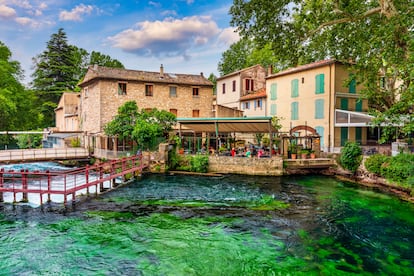
The Sorgue river, so industrious, originates in some cliffs in the locality called Fontaine de Vaucluse. This spring or spring is located on the outskirts of the town, in some cavities and caves explored by Commander Cousteau. But it was the Italian poet Francesco Petrarca who made the place famous, who walked here during the pontificate of Avignon, drawing inspiration from this enchanted landscape and marking with his verses a path towards Renaissance poetry throughout Europe. A museum in the town and a “Petrarchal column” in the municipal garden are dedicated to him, to remember his adventures through these places, perfect and elegant like a hendecasyllabic verse. And what less.
